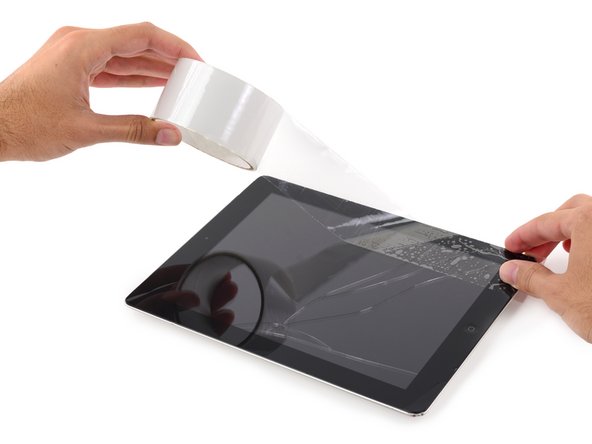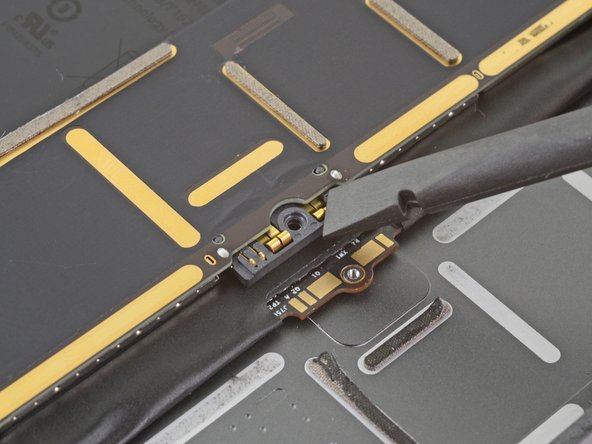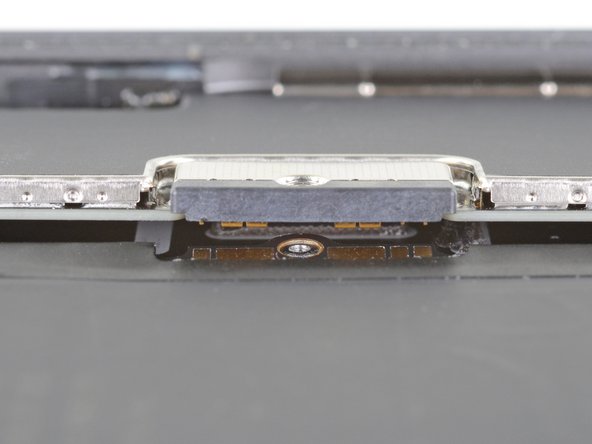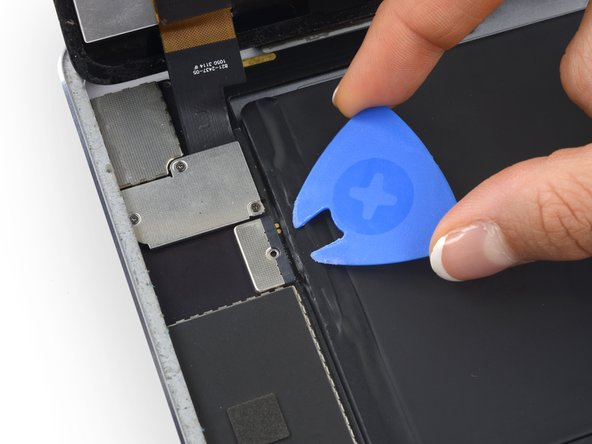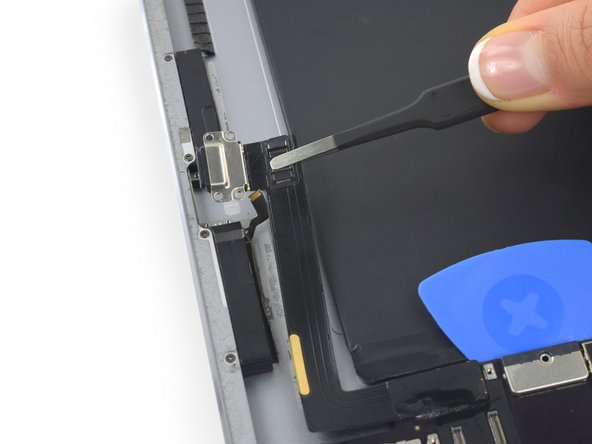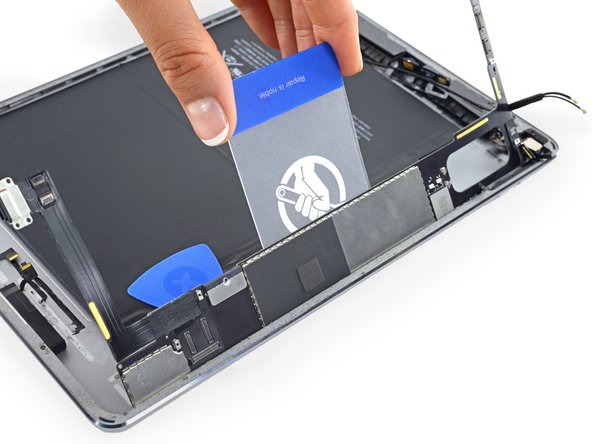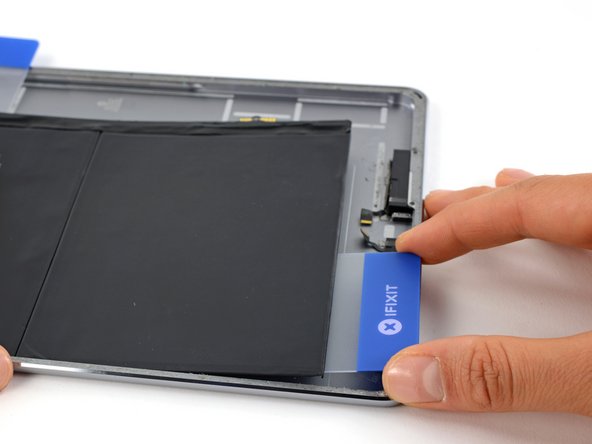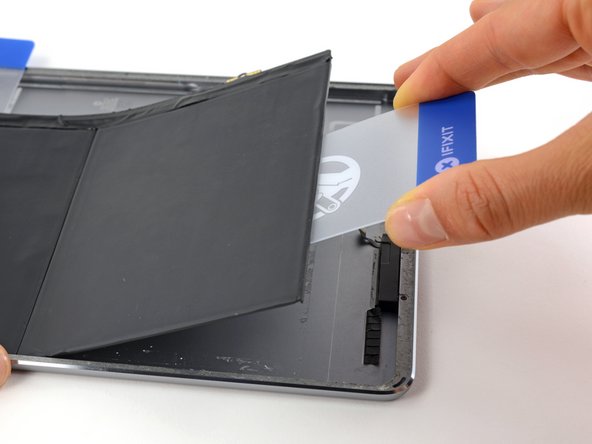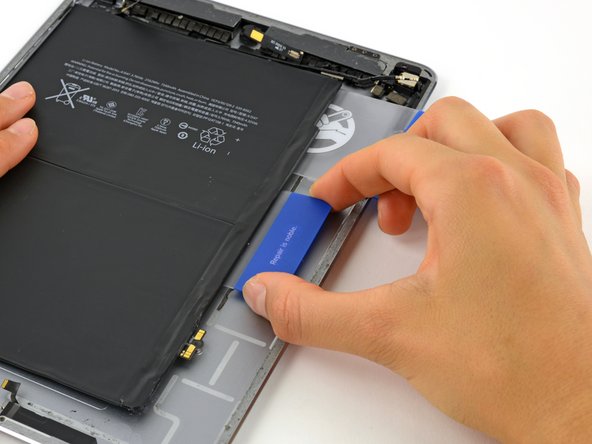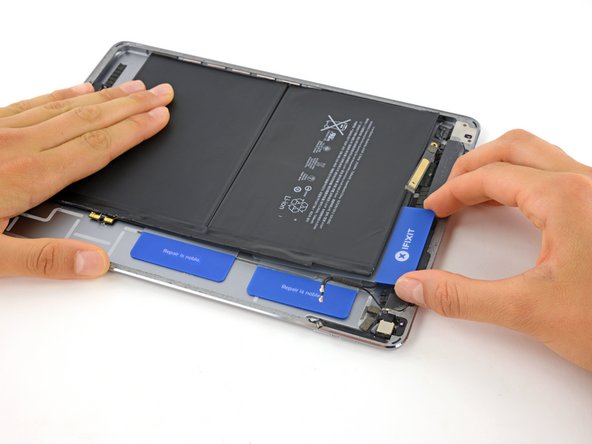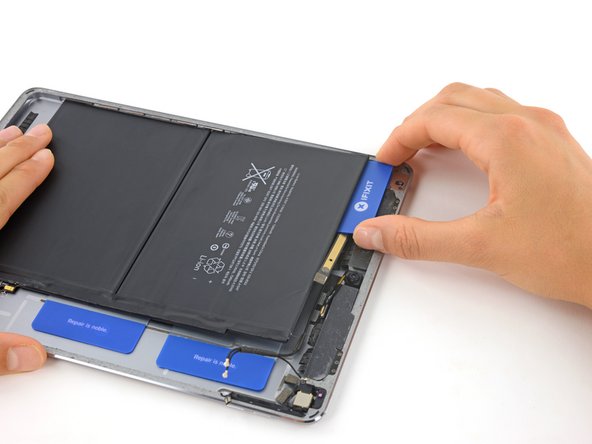Esta versão pode conter edições incorretas. Mude para o último instantâneo verificado.
O que você precisa
-
-
Encha uma panela ou frigideira com água suficiente para submergir completamente um iOpener.
-
Aqueça a água até ferver. Desligue o fogo.
-
Coloque um iOpener na água quente por 2 a 3 minutos. Certifique-se de que o iOpener esteja totalmente submerso na água.
-
Use um pegador para retirar o iOpener aquecido da água quente.
-
Seque bem o iOpener com uma toalha.
-
Sua bolsa térmica iOpener está pronta para o uso! Se precisar reaquecer o iOpener, aqueça a água até ferver, desligue o fogo e coloque o iOpener na água por 2 a 3 minutos.
-
-
Este passo não foi traduzido. Ajude a traduzi-lo
-
If your display glass is cracked, keep further breakage contained and prevent bodily harm during your repair by taping the glass.
-
Lay overlapping strips of clear packing tape over the iPad's display until the whole face is covered.
-
Do your best to follow the rest of the guide as described. However, once the glass is broken, it will likely continue to crack as you work, and you may need to use a metal prying tool to scoop the glass out.
-
-
Este passo não foi traduzido. Ajude a traduzi-lo
-
Handling it by the tabs on either end, place a heated iOpener over the top edge of the iPad.
-
Let the iOpener sit on the iPad for two minutes to soften the adhesive securing the front panel to the rest of the iPad.
-
-
Este passo não foi traduzido. Ajude a traduzi-lo
-
As you follow the directions, take special care to avoid prying in the following areas:
-
Home Button
-
Front Facing Camera
-
Main Camera
-
-
Este passo não foi traduzido. Ajude a traduzi-lo
-
Elevate the iPad enough for the Anti-Clamp's arms to rest above and below the screen.
-
Pull the blue handle towards the hinge to disengage opening mode.
-
Position the suction cups near the top edge of the iPad—one on the front, and one on the back.
-
Push down on the cups to apply suction to the desired area.
-
-
Este passo não foi traduzido. Ajude a traduzi-lo
-
Push the blue handle away from the hinge to engage opening mode.
-
Turn the handle clockwise until you see the cups start to stretch.
-
Wait one minute to give the adhesive a chance to release and present an opening gap.
-
Insert an opening pick under the screen when the Anti-Clamp creates a large enough gap.
-
Skip the next two steps.
-
-
Este passo não foi traduzido. Ajude a traduzi-lo
-
Place a suction cup over the iPad's front-facing camera and press down to create a seal.
-
-
Este passo não foi traduzido. Ajude a traduzi-lo
-
Firmly pull up on the suction cup to create a small gap between the front panel and the rear case.
-
Once you've opened a sufficient gap, insert an opening pick into the gap to prevent the adhesive from resealing.
-
-
Este passo não foi traduzido. Ajude a traduzi-lo
-
Slide the pick along the edge of the display, towards the headphone jack.
-
If there is still a considerable amount of resistance when sliding the opening pick, repeat the iOpener heating procedure and apply additional heat.
-
-
Este passo não foi traduzido. Ajude a traduzi-lo
-
Insert a second opening pick by the front-facing camera.
-
-
Este passo não foi traduzido. Ajude a traduzi-lo
-
Slide the second pick along the top edge of the iPad, towards the Sleep/Wake Button.
-
-
Este passo não foi traduzido. Ajude a traduzi-lo
-
Bring the right opening pick down and around the top right corner of the iPad.
-
-
Este passo não foi traduzido. Ajude a traduzi-lo
-
Bring the left opening pick around the top left corner of the tablet.
-
-
Este passo não foi traduzido. Ajude a traduzi-lo
-
Reheat the iOpener and lay it over the right edge of the display to loosen the adhesive underneath.
-
-
Este passo não foi traduzido. Ajude a traduzi-lo
-
Slide the right opening pick roughly halfway down the display.
-
-
Este passo não foi traduzido. Ajude a traduzi-lo
-
Reheat the iOpener and apply heat to the left side of the iPad.
-
-
Este passo não foi traduzido. Ajude a traduzi-lo
-
Slide the left-hand opening pick about halfway down the edge of the display.
-
-
Este passo não foi traduzido. Ajude a traduzi-lo
-
Slide the opposite opening pick down to the bottom right corner of the iPad.
-
-
Este passo não foi traduzido. Ajude a traduzi-lo
-
Slide the left-hand opening pick down the edge of the display until you reach the corner.
-
-
Este passo não foi traduzido. Ajude a traduzi-lo
-
Use the iOpener to apply heat to the bottom edge of the iPad.
-
-
Este passo não foi traduzido. Ajude a traduzi-lo
-
Bring the right-hand opening pick around the bottom corner of the iPad.
-
-
-
Este passo não foi traduzido. Ajude a traduzi-lo
-
Remove the right-hand opening pick at the bottom of the iPad.
-
-
Este passo não foi traduzido. Ajude a traduzi-lo
-
Slide the left-hand opening pick along the bottom edge of the display, then remove it from the bottom right corner of the iPad.
-
-
Este passo não foi traduzido. Ajude a traduzi-lo
-
Twist the remaining pick by the front-facing camera to separate the top edge of the display assembly from the rear case.
-
-
Este passo não foi traduzido. Ajude a traduzi-lo
-
Continue lifting the display assembly from the front-facing camera side.
-
Pull the display slightly away from the bottom edge to completely separate it from the rear case.
-
Keep lifting until the display assembly is roughly perpendicular to the body of the iPad.
-
-
Este passo não foi traduzido. Ajude a traduzi-lo
-
Remove the single 1.8 mm Phillips screw securing the battery terminals to their contacts on the logic board.
-
-
Este passo não foi traduzido. Ajude a traduzi-lo
-
Slide a battery isolation pick underneath the battery connector area of the logic board, and leave it in place while you work.
-
Alternatively, make a battery blocker using a playing card and slide it underneath the logic board connector to disconnect the battery.
-
-
Este passo não foi traduzido. Ajude a traduzi-lo
-
Remove the three 1.3mm Phillips screws from the display cable bracket.
-
Remove the bracket.
-
-
Este passo não foi traduzido. Ajude a traduzi-lo
-
Disconnect the display data connector from its socket on the logic board.
-
-
Este passo não foi traduzido. Ajude a traduzi-lo
-
Disconnect the two remaining digitizer cables underneath the display data cable.
-
-
Este passo não foi traduzido. Ajude a traduzi-lo
-
Remove the front panel assembly from the rear case.
-
-
Este passo não foi traduzido. Ajude a traduzi-lo
-
Remove the following four Phillips screws securing the upper component cable bracket to the tablet.
-
Two 1.6 mm
-
Two 1.3 mm
-
Slide the upper component cable bracket out from under the protective flaps and remove it from the iPad.
-
-
Este passo não foi traduzido. Ajude a traduzi-lo
-
Remove the tape covering the two speaker ZIF connectors.
-
-
Este passo não foi traduzido. Ajude a traduzi-lo
-
Use a spudger to flip up the retaining flap on the left speaker's ZIF connector.
-
-
Este passo não foi traduzido. Ajude a traduzi-lo
-
Slide the left speaker cable out of its ZIF connector.
-
-
Este passo não foi traduzido. Ajude a traduzi-lo
-
Use a spudger to flip up the retaining flap on the right speaker's ZIF connector.
-
-
Este passo não foi traduzido. Ajude a traduzi-lo
-
Slide the right speaker cable out of its ZIF connector.
-
-
Este passo não foi traduzido. Ajude a traduzi-lo
-
Use a spudger to gently pry up the antenna cables from their sockets.
-
-
Este passo não foi traduzido. Ajude a traduzi-lo
-
Firmly grasp the antenna cable and peel up the grounding tape attaching it to the logic board.
-
-
Este passo não foi traduzido. Ajude a traduzi-lo
-
Remove the 1.2 mm Phillips screw securing the bracket covering the volume control cable connector.
-
Remove the bracket.
-
-
Este passo não foi traduzido. Ajude a traduzi-lo
-
Detach the volume button cable connector by prying it straight up from its socket.
-
-
Este passo não foi traduzido. Ajude a traduzi-lo
-
Pry up the rear facing camera cable connector from its socket.
-
-
Este passo não foi traduzido. Ajude a traduzi-lo
-
Pry up the home button/microphone ribbon cable connector from its socket.
-
-
Este passo não foi traduzido. Ajude a traduzi-lo
-
Use the flat end of a spudger to disconnect the Facetime camera connector from its socket on the logic board.
-
Pry up the adhesive attaching the Facetime camera cable to the audio jack cable underneath.
-
Fold the Facetime camera cable up and out of the way.
-
-
Este passo não foi traduzido. Ajude a traduzi-lo
-
Disconnect the headphone jack cable connector from its socket on the logic board.
-
Pry the cable up to free it from the adhesive securing it to the rear case.
-
Pull the audio jack cable out of the way of the logic board below.
-
-
Este passo não foi traduzido. Ajude a traduzi-lo
-
Use tweezers to peel up the rightmost grounding tape attaching the antennas to the logic board.
-
Bend the antenna wire back and out of the way of the logic board.
-
-
Este passo não foi traduzido. Ajude a traduzi-lo
-
Peel up the tape covering the top left edge of the logic board.
-
-
Este passo não foi traduzido. Ajude a traduzi-lo
-
Remove the four 1.6 mm Phillips screws attaching the lightning port to the rear case.
-
-
Este passo não foi traduzido. Ajude a traduzi-lo
-
Insert an opening pick underneath the Lightning cable where it meets the logic board.
-
Slide the opening pick towards the bend in the cable.
-
-
Este passo não foi traduzido. Ajude a traduzi-lo
-
Pull the Lightning connector straight out of its recess in the rear case.
-
-
Este passo não foi traduzido. Ajude a traduzi-lo
-
Prepare an iOpener following the steps in the Aquecimento da bolsa térmica iOpener Guide.
-
Place the iOpener along the top of the back of the iPad for 2-3 minutes to soften the adhesive holding the logic board in place.
-
-
Este passo não foi traduzido. Ajude a traduzi-lo
-
Insert an opening tool underneath the logic board below the FaceTime camera.
-
Pry the left edge of the logic board up.
-
-
Este passo não foi traduzido. Ajude a traduzi-lo
-
Insert an opening pick underneath the portion of the logic board pried up in the previous step.
-
Slide the opening pick towards the volume control buttons, and stop at the bend in the logic board.
-
-
Este passo não foi traduzido. Ajude a traduzi-lo
-
Place a heated iOpener on the lefthand side of the back of the iPad for 2-3 minutes.
-
-
Este passo não foi traduzido. Ajude a traduzi-lo
-
Insert a plastic opening tool underneath the logic board, inside the rectangular cut out, and gently pry the logic board up.
-
Slide the opening tool down the length of the gap while continuing to pry the logic board up.
-
-
Este passo não foi traduzido. Ajude a traduzi-lo
-
Insert an opening tool underneath the logic board on the other side of the rectangular cut out and pry it up.
-
Slide the opening tool down the length of the gap while continuing to pry the logic board up.
-
-
Este passo não foi traduzido. Ajude a traduzi-lo
-
Insert a plastic card underneath the logic board.
-
Slide the card down the length of the logic board to release the adhesive.
-
-
Este passo não foi traduzido. Ajude a traduzi-lo
-
Slide a plastic card underneath the center of the logic board, pushing it in as far as it will go.
-
Slowly swing the left edge of the logic board up, while making sure it doesn't snag against any of the disconnected cables.
-
-
Este passo não foi traduzido. Ajude a traduzi-lo
-
Reheat the iOpener in the microwave for 30 seconds.
-
Place the heated iOpener in the center of the back of the iPad. Keep it there for 90 seconds to soften the battery adhesive.
-
Move the iOpener to the right (away from the rear-facing camera), and keep it there for another 90 seconds.
-
Finally, place the iOpener near the right-hand edge of the iPad for 90 seconds.
-
-
Este passo não foi traduzido. Ajude a traduzi-lo
-
Once the adhesive has had a couple minutes to soften, flip the iPad over, battery-side up.
-
Insert a plastic card underneath the battery contacts.
-
Push the card about an inch under the battery to begin breaking up the adhesive holding it in place.
-
-
Este passo não foi traduzido. Ajude a traduzi-lo
-
Slide the plastic card up along the edge of the battery until the card is even with the top edge of the battery.
-
-
Este passo não foi traduzido. Ajude a traduzi-lo
-
Insert a second plastic card underneath the battery contacts.
-
Rotate the plastic card around the lower right corner of the battery to begin breaking up the adhesive along the lower edge.
-
-
Este passo não foi traduzido. Ajude a traduzi-lo
-
Slide the second card along the bottom edge of the battery to continue breaking up the adhesive holding it to the rear case.
-
-
Este passo não foi traduzido. Ajude a traduzi-lo
-
Push the plastic card about two inches underneath the battery, and lift it up to pry the first battery cell off the rear case.
-
-
Este passo não foi traduzido. Ajude a traduzi-lo
-
Remove the card from the bottom of the battery and slide it between the battery and rear case, along the side and underneath the seam where the two battery cells meet.
-
Push the card as far underneath the battery as you can.
-
-
Este passo não foi traduzido. Ajude a traduzi-lo
-
Firmly grasp the first card you inserted underneath the battery and push it as far as you can underneath the battery.
-
-
Este passo não foi traduzido. Ajude a traduzi-lo
-
Slide a third card underneath the top edge of the battery, on the right side.
-
Push the card in as far as it will go, breaking through as much of the adhesive underneath the battery as you can.
-
-
Este passo não foi traduzido. Ajude a traduzi-lo
-
Remove the card and slide it under the top edge of the battery again, on the left side near the edge of the iPad.
-
Push the card in as far as it will go, breaking through as much of the adhesive underneath the battery as you can.
-
-
Este passo não foi traduzido. Ajude a traduzi-lo
-
Remove the card and again slide it under the top edge of the battery, near the center.
-
Slide the card in as far as it will go, breaking through as much of the adhesive as you can.
-
Lift up on the card to pry the second battery cell up from the rear case.
-
Cancelar: não concluí este guia.
233 outras pessoas executaram este guia.
57 comentários
Can the iPad air 2 battery be replaced without removing logic board or do all the internal components have to be dismantled before battery can be replaced?
The battery contacts are pinned underneath the logic board, so it's difficult to remove with the logic board in place. There's also very little room to work with the logic board installed, so there's an increased risk of damaging something with a wayward swipe of your card or pry tool. But yes, it's possible. You can reference this guide for tips on the procedure (it's for a different model but the same overall strategy will work).
I just finished this repair successfully. Don't force ANYTHING Find something, a steel plate, aluminum plate, a heat gun and heat the plates not the iPad. Then it does not over heat, it is even and does not get cool. That makes it really easy. I used a piece of 6" of channel beam and blew the heat in the channel, measuring the top with a laser thermometer (140F target) after step #37, it worked so much better. I lifted the battery w/o touching electronics, and logic board too. It was easy with separators from IFixIT and slabs from a milk carton.
I don't think anything was risky this way and should have used the beam for the 1-37 steps.
Thanks to all who contribute here.
I've just completed this fix (among 4-5 others previously). First comment here b/c this was an unusual repair. The biggest surprise about this fix (or anything to do with the internals of an iPad): the size of the screws! I'm surprised it isn't mentioned at the top, along with the PN000 driver: these things are literally the size of a grain of sand! So, taking them out is the easy part. Putting them back in is a trick. The secret: place them on the holes first, in whichever direction, then maneuver them btw fingernail and driver into correct position. You'll need something to anchor the screen in a vertical position to use both hands. Not mentioned in Jeff and AMT's comments: there is a loop in the battery contact. Not removing the logic board means you'll be breaking the loop on the old battery to remove it, and you'll need to snip the loop on the new battery to insert it. It all worked for me. It made the actual fix a fraction of the steps from the written one (just 4 screws removed), but it's risky.
I bought the $20 repair kit to go along with the lithium ion battery. The suction cup and the heating tube did not work even after multiple attempts to use the heating tube. I had to resort to a hair dryer and use a straight razor to pry the edge just enough to slip a pick in there. I did find incredible use for the magnetized screw drivers and spudgers.
I bought the iFixIt lithium ion battery replacement and once reassembling the iPad Air 2 (double checking each connection for fit and order), it still does not turn on. ugh…







